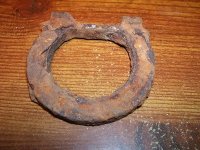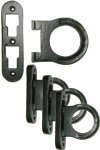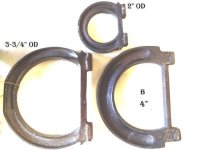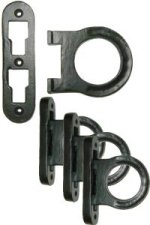You are using an out of date browser. It may not display this or other websites correctly.
You should upgrade or use an alternative browser.
You should upgrade or use an alternative browser.
possible heel plate???
- Thread starter TerryEastTexas
- Start date
T-Man
Elite Member
Cast iron bed rail support. Found one a few years ago and took me about 2 years to identify it.
http://robinsonsantiques.com/bed-hooks/bed-hooks-1-4.htm#bedh2
http://robinsonsantiques.com/bed-hooks/bed-hooks-1-4.htm#bedh2
Cast iron bed rail support. Found one a few years ago and took me about 2 years to identify it.
http://robinsonsantiques.com/bed-hooks/bed-hooks-1-4.htm#bedh2
Sir, what would it have used for? I'm unsure of your description.
Fear_me_Punk_11
Junior Member
Beds are of great interest to most people. We spend more time in bed than we do anywhere else, except maybe at work, so where we spend roughly one-third of our lives should be of great interest.
In medieval times, beds for most people were little more than nests of blankets on the floor or on a small platform of earth or stones. The problem? There were other critters at that same level of inhabitation: cats, dogs, cattle and assorted vermin and varmints. In the castles of the times, it was easy to build a large panel bed incorporated into the structure of the room because these people weren’t going anywhere in a hurry, but the peasants had to be prepared to move out in a hurry.
In Colonial America, mobility was a key factor in bed design. America has been a nation on the move since before it was a nation, so a bed that could be disassembled, transported by wagon or boat and reassembled was a valuable asset.
One early solution to the portable sleeping platform problem was the rope bed, a suspension system of ropes pulled through or tied to a frame, most often of maple or cherry. But rope beds are singularly uncomfortable, and the rope suspension must be periodically restrung to take up the slack generated by the stretching of the rope — thus leading to the origin of the phrase “sleep tight.” All in all, it was a cumbersome solution to the problem whose only virtue was its elevation off the critter-infested floor.
Another solution was the type of hardware and frame found in many late-18th century and early Federal-era beds. This consisted of a frame with a headboard, footboard and side rails, all held together by handmade bolts (as they all were in the early Federal era) that passed through the bedpost and engaged a nut implanted in the side rail. As the bolt was tightened with a bed wrench, the post was held snugly to the side rail, and the periodic adjustments needed due to wood expansion and contraction were relatively simple compared with the contortions required for a rope bed. This type of rigid frame made the addition of a spring unit and a thick mattress a natural addition to comfort.
A variation of this frame was used in the construction of Empire-era beds. But in this case, the bolt was located within a channel cut in the side rail, invisible from the exterior of the bed. The bolt penetrated into, but not through, the post where it engaged an imbedded nut. Adjustments were a little more inconvenient, because the bedding had to be moved to get to the bolts, but the trade-off was an exterior free of exposed functional hardware.
Both of these arrangements resulted in extremely secure bed platforms that were, indeed, highly portable and easy to disassemble and reassemble — but they did have a common drawback. They were relatively difficult to make by hand, because each bolt and each nut had to be in perfect alignment, and each bolt and each nut was handmade, and, thus, not necessarily interchangeable with another piece of hardware. Woe to he who lost a bolt from a side rail or bedpost in transit.
The corresponding nut had to be dug out of the matching piece and a new set of hardware installed: not a five-minute job.
By the mid-19th century, the Industrial Revolution was well grounded in America, and nuts and bolts were no longer handmade, but a great deal of the furniture still was. The great furniture factory systems of the Midwest were not fully cranked up yet, and most beds were still laboriously cut and assembled by hand, including installing and aligning the hardware sets that held them all together. As the factories expanded in scope and capability after the Civil War, those things that could not be adapted to machine production began to fall away, and beds were no exception.
The Victorian solution to bed hardware was extremely simple and easily machine compatible. The most common approach consisted of creating a circular brace in a side rail, into which was fitted what looked like a horseshoe with a bar across the end. The result was a piece of cast iron that looked like a capital “D” with two protrusions on the flat side. After this device was installed in the side rail, a cover board was nailed over it, so that all that was visible were the two protrusions. These two ears matched up with a fitting installed in the headboard post that locked the rail into the post in one downward motion. Brilliant. All the hardware was machine made, and a good part of the installation was also done by machinery.
The only drawback to this system, which lasted until nearly 1900, was the fact that it used a lot of metal, which made it heavy to ship. Naturally, another machine-oriented solution showed itself. This new method consisted of a very thin stamped — not cast — steel fixture inserted into a slit in the side rail and affixed by two steel pins. This fixture had two protruding curved hooks, which entered a matching slit in the headboard post and engaged two more steel pins using the same downward motion as the Victorian example, thus securing the rail to the post. And it used less than 20 percent of the metal of its predecessor.
This is the system most in use today and represents a technology and an idea essentially unchanged for more than 100 years.
In medieval times, beds for most people were little more than nests of blankets on the floor or on a small platform of earth or stones. The problem? There were other critters at that same level of inhabitation: cats, dogs, cattle and assorted vermin and varmints. In the castles of the times, it was easy to build a large panel bed incorporated into the structure of the room because these people weren’t going anywhere in a hurry, but the peasants had to be prepared to move out in a hurry.
In Colonial America, mobility was a key factor in bed design. America has been a nation on the move since before it was a nation, so a bed that could be disassembled, transported by wagon or boat and reassembled was a valuable asset.
One early solution to the portable sleeping platform problem was the rope bed, a suspension system of ropes pulled through or tied to a frame, most often of maple or cherry. But rope beds are singularly uncomfortable, and the rope suspension must be periodically restrung to take up the slack generated by the stretching of the rope — thus leading to the origin of the phrase “sleep tight.” All in all, it was a cumbersome solution to the problem whose only virtue was its elevation off the critter-infested floor.
Another solution was the type of hardware and frame found in many late-18th century and early Federal-era beds. This consisted of a frame with a headboard, footboard and side rails, all held together by handmade bolts (as they all were in the early Federal era) that passed through the bedpost and engaged a nut implanted in the side rail. As the bolt was tightened with a bed wrench, the post was held snugly to the side rail, and the periodic adjustments needed due to wood expansion and contraction were relatively simple compared with the contortions required for a rope bed. This type of rigid frame made the addition of a spring unit and a thick mattress a natural addition to comfort.
A variation of this frame was used in the construction of Empire-era beds. But in this case, the bolt was located within a channel cut in the side rail, invisible from the exterior of the bed. The bolt penetrated into, but not through, the post where it engaged an imbedded nut. Adjustments were a little more inconvenient, because the bedding had to be moved to get to the bolts, but the trade-off was an exterior free of exposed functional hardware.
Both of these arrangements resulted in extremely secure bed platforms that were, indeed, highly portable and easy to disassemble and reassemble — but they did have a common drawback. They were relatively difficult to make by hand, because each bolt and each nut had to be in perfect alignment, and each bolt and each nut was handmade, and, thus, not necessarily interchangeable with another piece of hardware. Woe to he who lost a bolt from a side rail or bedpost in transit.
The corresponding nut had to be dug out of the matching piece and a new set of hardware installed: not a five-minute job.
By the mid-19th century, the Industrial Revolution was well grounded in America, and nuts and bolts were no longer handmade, but a great deal of the furniture still was. The great furniture factory systems of the Midwest were not fully cranked up yet, and most beds were still laboriously cut and assembled by hand, including installing and aligning the hardware sets that held them all together. As the factories expanded in scope and capability after the Civil War, those things that could not be adapted to machine production began to fall away, and beds were no exception.
The Victorian solution to bed hardware was extremely simple and easily machine compatible. The most common approach consisted of creating a circular brace in a side rail, into which was fitted what looked like a horseshoe with a bar across the end. The result was a piece of cast iron that looked like a capital “D” with two protrusions on the flat side. After this device was installed in the side rail, a cover board was nailed over it, so that all that was visible were the two protrusions. These two ears matched up with a fitting installed in the headboard post that locked the rail into the post in one downward motion. Brilliant. All the hardware was machine made, and a good part of the installation was also done by machinery.
The only drawback to this system, which lasted until nearly 1900, was the fact that it used a lot of metal, which made it heavy to ship. Naturally, another machine-oriented solution showed itself. This new method consisted of a very thin stamped — not cast — steel fixture inserted into a slit in the side rail and affixed by two steel pins. This fixture had two protruding curved hooks, which entered a matching slit in the headboard post and engaged two more steel pins using the same downward motion as the Victorian example, thus securing the rail to the post. And it used less than 20 percent of the metal of its predecessor.
This is the system most in use today and represents a technology and an idea essentially unchanged for more than 100 years.
Attachments
Good ID folks. Thanks for the info.
Similar threads
- Replies
- 2
- Views
- 116





